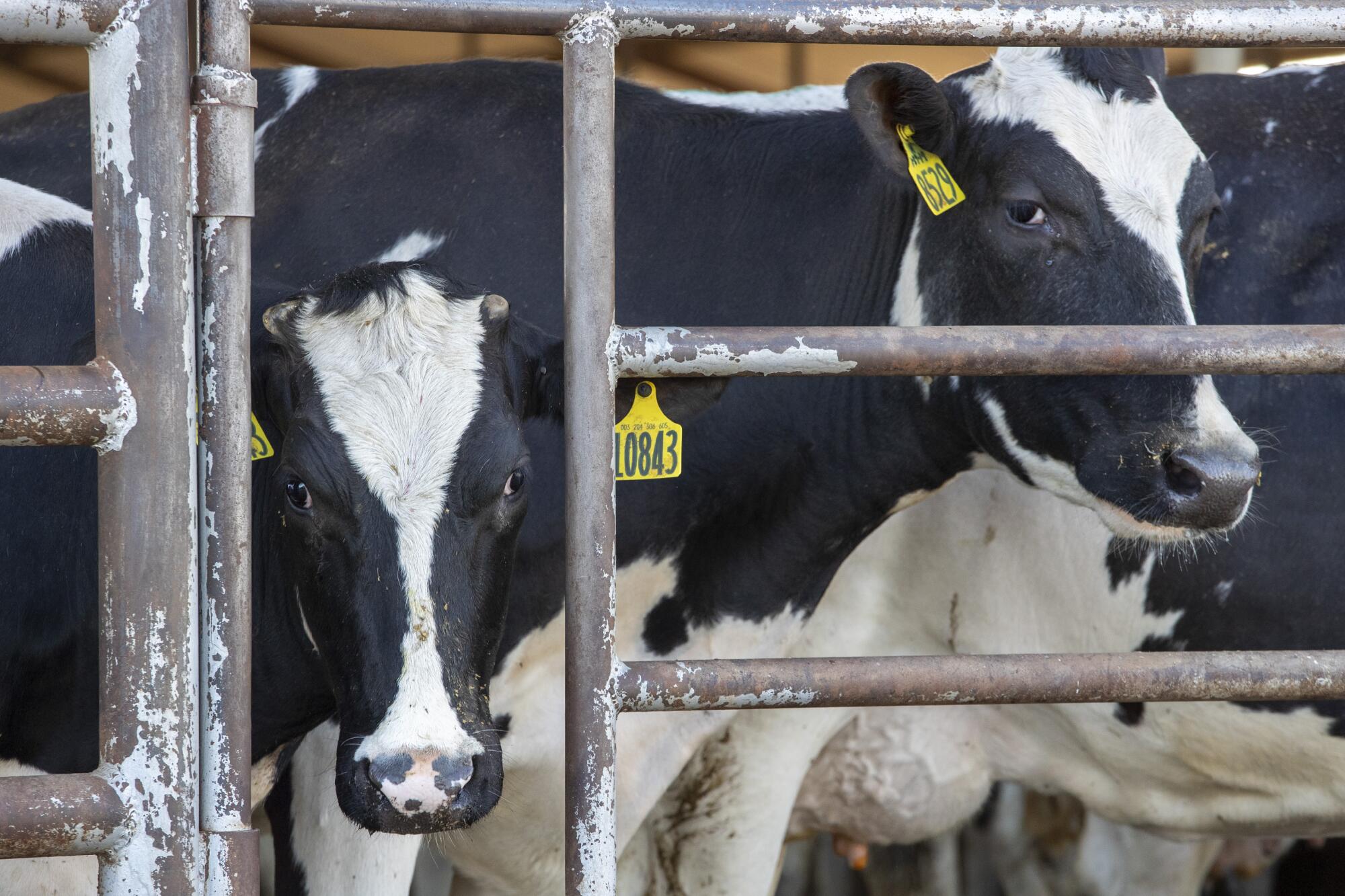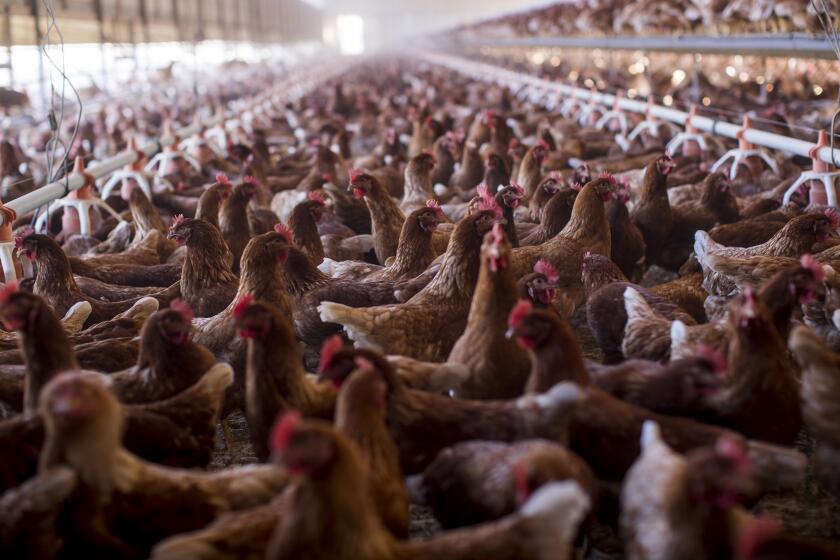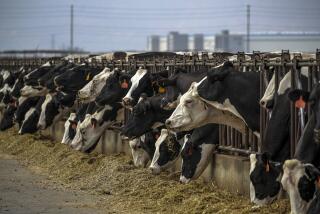
- Share via
After identifying remnants of bird flu virus in grocery store milk, federal officials announced Wednesday that they “believe” the nation’s milk supply is safe and that the virus is inactivated by pasteurization.
“Heating milk to a specific temperature for a set period of time through pasteurization is done to limit the activity of pathogens to a level that does not pose a risk to consumer health,” said Don Prater, acting director of the U.S. Food and Drug Administration’s Center for Food Safety and Applied Nutrition.
However, Prater acknowledged that “no studies on the effects of pasteurization on HPAI (high pathogenic avian influenza) viruses and bovine milk have previously been completed.”
Wednesday’s assurance of safety follows a series of bird flu outbreaks in dairy farms in eight states. FDA scientists said they have identified genetic material from the current bird flu strain in samples of pasteurized milk from grocery shelves. The DNA testing done so far was unable to determine conclusively whether the viral particles were active or inactive.
Prater described the situation as novel and evolving but asserted that pasteurization and sterilization have “served public health well for over 100 years.”
News that Midwestern dairy cows may have become infected with avian flu by eating poultry waste has many asking: What are American farm animals being fed? And should we be concerned?
Studies done on similar virus types indicate that while pasteurization may not eliminate the virus, it will inactivate it, said Suresh Kuchipudi, professor and chair of the department of infectious disease and microbiology at the University of Pittsburgh’s School of Public Health.
Dawn O’Connell, Health and Human Services assistant secretary for preparedness and response, stressed that the risk to human health is low but that the federal government remains “watchful and ever ready ... to keep the American people safe.”
California’s State Veterinarian, Annette Jones, said there have been no detections of the virus in California cattle, and that a network of state and private veterinarians have been in close communication with the dairy industry and individual farmers.
Despite such assurances, however, some experts have questioned the timeliness of the government’s response to the outbreak.
Eric Topol, a professor of Molecular Medicine at Scripps Research, said that while he was happy the government was finally coming together in a united front to present information Wednesday, “it sure took a while.”
He said the government has likely been aware for weeks — if not a couple of months — of the positive samples. He noted the release on Sunday night of 239 DNA sequences that revealed the presence of virus in commercial milk samples.
“They didn’t just get those sequences overnight,” Topol said. “They’ve had them.”
The analysis of those sequences suggests a single origin of the virus in dairy cattle during some point in late 2023 or early 2024 — most likely from an infected bird, but possibly from infected food.
“I don’t know that we’re out of the woods by any means, because now there’s so much spread among the cattle in the country that all we need is one bad recombination event,” said Topol, referring to the possibility of the genes in a human flu virus mixing with those in the cattle virus to create a new, or altered version that could be more problematic to people.
“It feels like Covid all over again,” Topol said, recalling the response of officials in the weeks and months after the pandemic began to spread in early 2020.
At Wednesday’s news conference, officials said that researchers were actively testing viral particles found in milk samples in the laboratory to see whether they could be grown in either cell cultures or embryonated chicken eggs. These tests, said Jeanne Marrazzo, director of the National Institute of Allergy and Infectious Diseases, will indicate whether the virus is active, or not.
Government officials and researchers said they were expanding their surveillance and monitoring and suggested that more information will be released in the days to come.
They also issued a federal order requiring that laboratories report any dairy cattle testing positive for avian flu or any type of influenza A, as well as the testing of all lactating dairy cattle moving between states. In addition, any farm where bird flu positive cows have been discovered will be required to undergo epidemiological investigation and movement tracing, said Mike Watson, administrator for the Animal and Plant Health Inspection Service.
Details on the number of milk samples tested, as well as where, how and why they were obtained were not shared with reporters
As the avian flu continues to threaten poultry farms and wildlife, are factory farms a sitting duck?
At least one outside expert said they doubted that government researchers would find an active virus in milk samples
“I would bet five mortgage payments” that that they won’t find live or active virus in the samples, said Michael Payne, a researcher and outreach coordinator at the Western Institute for Food Safety and Security at UC Davis.
“As an Eagle Scout (North East Georgia Council, 1976) I say this to you with completely honesty and transparency: I would not hesitate to drink, nor would I hesitate to serve to my family, pasteurized milk from any dairy herd in the United States,” he said.
During the news onference, officials said they were also keeping a close eye on cases of human infection.
Nirav Shah, principal deputy director of the U.S. Centers for Disease Control and Prevention, said the agency has tested 23 people for the virus and is actively monitoring 44 people “who are considered exposed and at risk for infection.”
So far, only one human case has been identified in the current outbreak, and that person was reported to have exhibited only mild symptoms.
In other places where humans have been infected however, the virus has made people sicker and has even been lethal. According to the World Health Organization, which has been tracking the virus, between January 2003 and February 2024, there were 887 confirmed cases of human infection across 23 countries. Of those, 462 were fatal.
While the current virus has not developed the ability to become more transmissible to humans, researchers have noted some worrisome mutations.
These include the observations of the virus spreading between cows within the same herd, from cows to poultry, and the movement of the virus between dairies associated with cattle movements. It’s also been detected in cows that didn’t have clinical signs of the disease — suggesting it is moving unnoticed.
In addition, on April 16, a USDA microbiologist “identified a shift” in one sample from McAllen, Kan., that appeared to show a mutation that would make it more transmissible between mammals, said Watson, the USDA official. He said further analyses by the CDC showed “low risk overall.”









